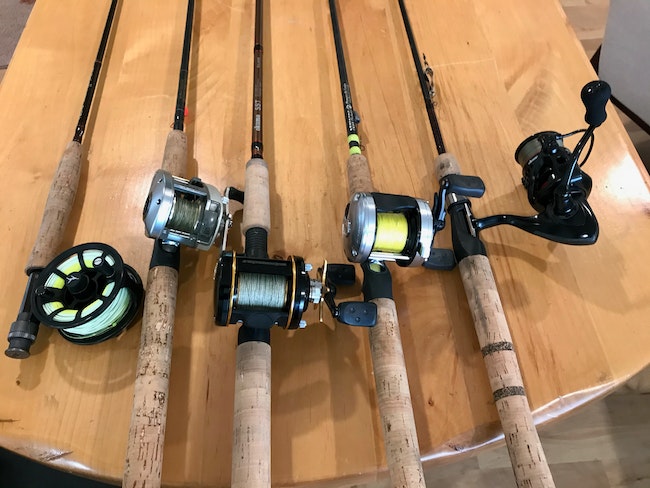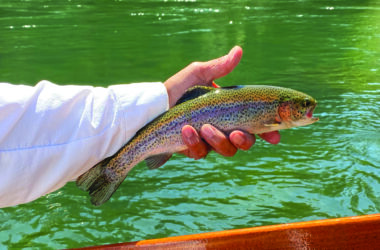 FRANK ARMENDARIZ/PHOTO Rods, reels and lines, the number of available options can be staggering. But if you follow the numbers printed on every rod and reel you can easily narrow it down and find a combination perfectly matched to what you want to fish for.
FRANK ARMENDARIZ/PHOTO Rods, reels and lines, the number of available options can be staggering. But if you follow the numbers printed on every rod and reel you can easily narrow it down and find a combination perfectly matched to what you want to fish for.
A question I’m asked quite often is, “What is the best all-around line, reel and rod for fishing in Oregon?” I always pause for a moment, assume a thoughtful look, then explain that so many species of fish are available to Oregon anglers that honestly there is no single rod and reel combination that will cover it all.
The only advice I can ever offer is to suggest whatever you choose, it should be balanced. Meaning the rod, reel and line should all be compatible in size. And that whatever balanced package you decide on really depends on what you enjoy or want to fish for.
There are several generalities about fishing in the Pacific Northwest that might help narrow down the search.
With so many cool-water resources in Oregon we have no shortage of places to fish and there are naturally occurring species of fish that populate many of them. The state of Oregon also has an aggressive hatchery program and raises trout that it planted in our waterways by the hundreds of thousands across the state every season. Added to the trout are abundant numbers of sunfish species like river smallmouth bass, crappie and freshwater perch — all fish that generally range in size from a few ounces up to about four pounds. This size class of fish across the range of species also provides the greatest amount of sporting opportunities for fish that you can often retain, and these fisheries also attract the largest number of anglers.
Moving up the scale, larger in size are a number of medium-sized fish. Including a couple of species of char, lake trout, steelhead, coho salmon and even largemouth bass fall into this class. These fish can all easily grow to five pounds and more. In the case of the char, lake trout, steelhead and coho, some will surpass 20 pounds. These are also very popular but challenging fisheries. The fact is the technical aspects of catching larger fish often increases with the size of the fish.
And finally, we have large fish like salmon which is the most popular in the size class but there are others. All of which have the potential to grow to 30 pounds or more. A lot of salmon get caught in the ocean but Oregonians are still by far salmon fishing in our rivers.
Breaking it down to what is available to fish for in Oregon, the best rod-and-reel package is actually three individual rod-and-reel combinations.
Of course there are other species of fish that grow much larger, and specialized rods have been innovated around their pursuit. But most of us fish for species close to where we live and that fall into one three specific rod classes. Light weight rods for 2-6 pound line, great for trout. Medium weight rods that handle 8-14 pound lines are a good choice for steelhead and heavyweight rods for 16-24 pound lines have the backbone for salmon. I see folks pick up a new rod, look at the price tag, wiggle it a bit and say, “Oh that feels good” and head for the cash register. Never examining the rod for the range of compatible line strengths it was built for, that is printed on the rod right above the handle. End up with a piece of gear that potentially will only compromise their angling experience.
Reels are also manufactured in a range of sizes to accommodate the line strength compatible to the rod you are matching them to. Reel manufacturers have also taken most of the guesswork out of choosing a reel as most reels have the line strength it was built for and how many yards of line will fit on the spool printed right on the reel. All of my gear for trout and other pan fish are spinning rod-and-reel combinations; they cast small lures and baits much easier than any other style of reel. Level wind reels dominate my collection for medium and large fish. I like to back troll from my drift boat for the larger fish and level wind reels are better suited for that style for angling. If you bank fish and are looking for your first steelhead rod? I would encourage you to consider the spinning rod-and-reel combination, the simplicity of its function will minimize the challenges of an already challenging fishery.
I was in a big box sporting goods outlet recently and was impressed by the number of fishing lines that are now available. Many are what would be called “speciality lines” that have come on the market to meet the many tactical approaches to angling that have been innovated in recent years. For my fishing I use three different types of line, all my spinning reels are spooled with a low-memory monofilament fishing line. Stren fishing line came on the market in 1958 and is still the top selling line. I have “high vis blue” on my spinning tackle and have since I was a kid …
For medium and large fish I switched all my level wind reels to 50-pound “spectra” also called “braided” fishing line years ago. The no-stretch characteristics of spectra fishing lines are perfect for back trolling and transmit even the lightest strikes directly to the rod handle, resulting in more and more solid hookups. Spectra is highly resistant to ultraviolet and has an incredible lifespan. I used to replace all the monofilament lines on my reel every couple of years but once you spool a reel with a spectra braid it will likely be the last line you will ever buy for that reel. When the front begins to get fuzzy from wear, just turn the line around and you’re good for another decade or two.
It is important to never tie a lure directly on to a spectra line. I alway add a 10-to-20-foot bumper section of 8-to-20-pound fluorocarbon line before attaching any lure. The bumper serves a few purposes, fluorocarbon is a very low stretch line so when matched to a spectra mainline it maintains its no-stretch quality and in turn the sensitivity spectra lines are famous for. Another quality of fluorocarbon is that in water it becomes invisible to fish and makes for a more natural lure presentation. Finally a bumper section ahead of your spectra braided lines is a benefit to the environment and to any wildlife that might become entangled. Trapped in a mess of mono fishing line most birds and other wildlife have little chance but wrapped in spectra braided lines that can last for over 20 years in the environment, they have absolutely no chance. A 20-pound bumper attached to 50-pound spectra will 100 percent of the time break at the knot and minimize what you might accidentally leave behind.
Email:








